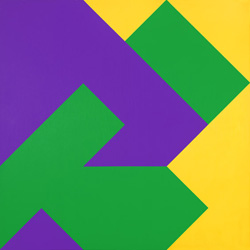
Continuing through December 24, 2011
I remember the time I first saw a Karl Benjamin painting, in the mid-1970s at one of the galleries at the Claremont Colleges. The painting depicted a grid of primary colors, yellow, aqua and bright green as oblique lines and trapezoids, all set energetically against a quietly neutral background. I marveled at the vibrancy of the chromatic clash. The color adjacencies seemed to sing with a magisterial energy, investing the very air with an alien, but poised, musicality. Then, moving in for a closer look at the surface of the work, I was astonished at the fastidious surface of the canvas. How did the man create such clean edges for those blocks of color? How were those impeccable surfaces generated? Surely, not with a paint brush, I speculated.
This approach to painting had been termed “Hard-edged,” and, I soon learned, was considered an actual “school” of California art making. I was certain that Benjamin had to be the very embodiment of this school. He was. and still is today. Others among them I would certainly number California minimalist sculptor Tony Delap, who has his own fastidious touch with the painted edge. Early success came for Benjamin with the 1959 exhibition titled ”Four Abstract Classicists“ organized by Jules Langsner for the Los Angeles County Museum (which several years later split off into the Natural History Museum of Los Angeles County and the Los Angeles County Museum of Art). Lorser Feitelson, John McLaughlin and Frederick Hammersley were the three other painters featured in the exhibit, and it proved to be a landmark for abstract painting in Los Angeles. To quote the Wikipedia citation about this exhibit, “The West Coast artists’ crisp abstractions offered a bracingly cool alternative to New York’s emotion-and action-packed style.”
The term “hard-edged” was actually coined by Langsner writing in the exhibition catalogue. When the show traveled to the San Francisco Museum of Art, the Institute of Contemporary Art in London and Queen’s College in Belfast, North Ireland it was re-named “West Coast Hard-Edge.” Langsner also wrote that in Benjamin’s hands “color and shape are one and the same entity.” That, and a persistent revisitation of complementary colors in variegated adjacency, constitutes more than a sufficient artistic strategy upon which to build a painting career that has lasted more than half a century. The paintings in the current exhibit, however, cover the thirty year period that began in 1950, in keeping with the scope of the Pacific Standard Time agenda for Art in L.A. The selection here is a fine opportunity to engage with representative examples of the seminal work of an important Southern California painter whose art remains among the finest of its kind, and unsurpassed as a chromatic and structural language.
